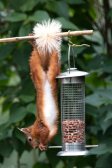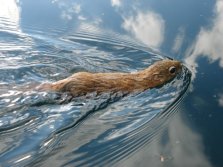Red Squirrel
The red squirrel is a member of the rodent family. Squirrels are distinguishable by their long bushy tails, which can measure almost the same as their body length. Body length can measure up to about 23cm whereas their tails can grow to about 20cm. Adult red squirrels can weigh up to 340g and fully-grown males and females are generally the same size. This means that the species is not sexually dimorphic.
The red squirrel is a native species of Ireland, living in wooded areas in nests known as ‘dreys’. Dreys are made from foliage, sticks and bark against trunks, limbs and holes in trees. Red squirrels are know as an ‘arboreal’ species, which means that they spend most of their lives high in the trees.
The red squirrel’s diet consists of fruits, seeds and berries. Their diet varies depending on seasonal availability. Contrary to popular belief, red squirrels do not hibernate. They do, however, forage and horde food during the plentiful autumn season to ease the harsh winter period.
Irish red squirrels reproduce once or twice a year, depending on the abundance of food. Gestation period is about 40 days, with young being bald and blind when born. Young squirrels are independent after about 10 weeks. The average lifespan for a red squirrel is about three years, however, females generally live longer than males and can sometimes live up to six years.



Conservation Status
The red squirrel is categorised by the IUCN Red List as ‘Least Concern’. The IUCN has justified this classification by the population size and wide distribution of the species. Despite obvious local examples of threats, such as the invasive grey squirrel (Sciurus carolinensis) in Ireland, there are no widespread, global threats to the red squirrel population.
In Ireland the biggest threat facing the red squirrel is the aforementioned grey squirrel. The grey squirrel are an invasive species to Ireland, having been introduced sometime in the mid 20th century from North America. The grey squirrel is highly adaptive and a voracious feeder, leading to a lack of food sources for the red squirrel. One interesting point is that areas with an increased pine marten (Martes martes) population have seen a decrease in the population size of grey squirrels, and an increase in population size of red squirrels. This is due to the fact that pine martens prey on grey squirrels, but rarely prey on red squirrels.
Interesting Facts
Handy: Red squirrels have been observed to favour either their right or left hands when eating. This trait is known as laterality and is not common in many animals.
Swimmers: Red squirrels are quite strong swimmers with some evidence suggesting that they are capable of swimming long distances. When they swim, their large tails provide buoyancy and steering.

We have our own versions of red squirrels in the US, but I imagine they are different species. Do you know why male red squirrels don’t live as long as females? I’m wondering if they might be more prone to taking risks.
LikeLiked by 1 person
Honestly, I’m not 100% sure about the reasons why! It is definitely interesting though, perhaps it is due to risk taking. Females can only mate twice a year but males can mate year round – so perhaps risk taking is being driven by this? But I do
not know if that is related at all! I would like to find out why though!
LikeLiked by 1 person
If males spend more time running about and looking for mates, then it might expose them more to predators…or cars. But like you pointed out, speculation alone won’t reveal much! Perhaps someone should look into why male red squirrels usually don’t live as long as females 😉
LikeLiked by 1 person